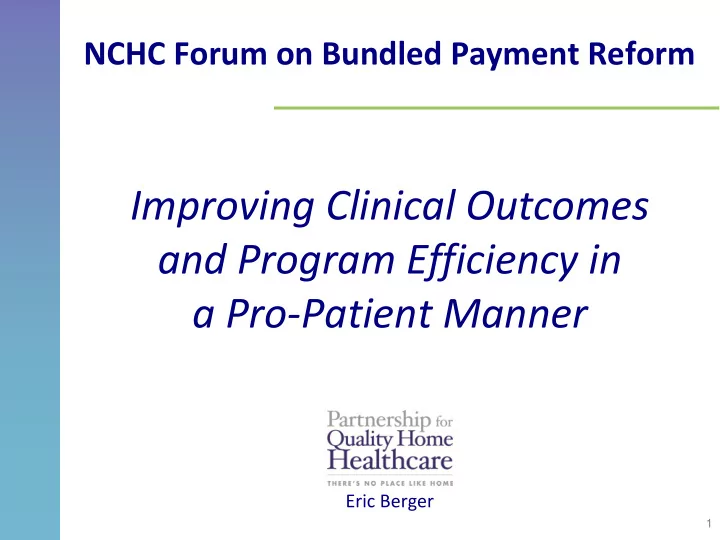

NCHC Forum on Bundled Payment Reform Improving Clinical Outcomes and Program Efficiency in a Pro-Patient Manner Eric Berger 1
Partnership Perspective • Numerous indicators evidence the need for reform. • Reform can be positive for both the Medicare program and beneficiaries through: • Sustainable payment reform mechanisms • Patient protections and choice • Program stability safeguards • With such reform, quality improvement, payment efficiency, and program sustainability are within reach. 2
Distribution Inefficiency • MS-DRGs Ranked by Medicare Episode Payment Show Overlap by First Setting Overall Top 9 MS-DRGs Ranked by Medicare Episode Paid, by First Setting MS-DRG Med/Surg Overall HHA SNF IRF LTCH 470: Major joint replacement or reattachment of lower extremity w/o MCC Surgical 1 1 1 1 34 871: Septicemia or severe sepsis w/o MV 96+ hours w MCC Medical 2 6 3 20 3 291: Heart failure & shock w MCC Medical 3 2 7 29 9 003: ECMO or trach w MV 96+ hrs or PDX exc face, mouth & neck w maj O.R. Surgical 4 91 31 10 1 194: Simple pneumonia & pleurisy w CC Medical 5 9 5 65 22 481: Hip & femur procedures except major joint w CC Surgical 6 73 2 3 53 292: Heart failure & shock w CC Medical 7 3 14 63 37 065: Intracranial hemorrhage or cerebral infarction w CC Medical 8 29 6 2 30 392: Esophagitis, gastroent & misc digest disorders w/o MCC Medical 9 20 35 125 80 Alliance for Home Health Quality and Innovation website: http://ahhqi.org/research/cacep. Source: Dobson, A. et al. (2012, October). Clinically Appropriate and Cost-Effective placement (CACEP): Improving health care quality and efficiency. Notes: Dobson | DaVanzo analysis of research-identifiable 5% SAF for all sites of service, 2007-2009, wage index adjusted by setting and geographic region, and standardized to 2009 dollars. Medicare Episode Paid includes care from all facility-based and ambulatory care settings and excludes beneficiary co-payments and Part D payments. 3
Distribution Inefficiency • Frequencies of Primary Chronic Conditions Also Show Overlap by First Setting Primary Chronic Condition for MS-DRG 470 (major joint replacement w/o MCC) for Post-Acute Episode (Ranked by Medicare Episode Paid) by Select First Setting (2007-2009) Primary Chronic Condition HHA Overall SNF IRF LTCH STACH Community Rheumatoid Arthritis/Osteoarthritis 1 1 1 2 3 1 1 2 Osteoporosis 2 2 2 1 1 3 Chronic Obstructive Pulmonary Disease 3 5 5 5 7 4 4 CHF*COPD 4 3 3 3 2 2 3 DIABETES*CHF 5 4 4 4 4 5 5 CHF*RENAL 6 6 7 6 5 6 6 None 7 8 9 9 * 10 7 Lung Cancer 8 9 8 8 * 8 9 Hip/Pelvic Fracture 9 7 6 7 6 7 8 Ischemic Heart Disease 10 10 10 10 * 9 10 Depression 11 11 11 12 * * 12 Cataract 12 12 17 * * 11 11 Diabetes 13 13 13 13 * * 15 Chronic Kidney Disease 14 15 16 14 * * 14 Heart Failure 15 14 12 11 * * 13 * Primary Chronic Condition not present in this setting 4
Cost Implications • Distribution Inefficiency Correlates to Higher Program and Beneficiary Costs Medicare Episode Paid for MS-DRG 470 (major joint replacement w/o MCC) for Post-Acute Episode by Select First Setting (2007-2009) Average Difference Number of Medicare from Overall First Setting Episodes Episode Paid Paid HHA 366,140 $18,068 $5,411 SNF 430,240 $26,861 ($3,382) IRF 128,680 $33,538 ($10,059) LTCH 1,080 $57,896 ($34,417) STACH 2,580 $30,302 ($6,823) Community 134,240 $17,340 $6,140 Total 1,062,960 $23,479 $0 Source: Dobson | DaVanzo analysis of research-identifiable 5% SAF for all sites of service, 2007-2009, wage index adjusted by setting and geographic region, and standardized to 2009 dollars. All episodes have been extrapolated to reflect the universe of Medicare beneficiaries. Medicare Episode Paid includes care from all facility-based and ambulatory care settings and excludes beneficiary co-payments and Part D payments. Note: ER, OP, OP Therapy, Hospice and Other IP first setting episodes are not included. 5
Savings Opportunity • Clinically Appropriate and Cost Effective Placement (CACEP) Model Projections Projected Medicare Ten-Year Savings (2014-2023) as a Percent of Medicare Post-Discharge Spending $120 $100.0 Medicare Post-Discharge Savings (in billions) (7.5%*) $100 $70.0 $80 (5.3%*) $60 $34.7 $40 (2.6%*) $20 $0 CACEP w/o CACEP w/payment adjustment payment adjustment Source: Dobson | DaVanzo analysis of research-identifiable 5% SAF for all sites of service, 2007-2009, wage index adjusted by setting and geographic region, and standardized to 2009 dollars. * Percent of post-acute care spending after discharge from the Index hospital. 6
Important Protections • Safeguards Needed for Participating Patients and to Ensure Program Stability Patient Choice Model Freedom to choose coordinator model. Network Freedom to choose network of PAC providers. Provider Freedom to choose PAC providers within network. Provider Capacity Scope PAC bundling first to smooth transition to DRG/PAC integration. Risk Assumption and management of risk by experienced entities. Program Stability Catchment Area Sufficient breadth to reduce risk to access and operations. 7
Concluding Thoughts • An incremental model may be most suitable to reform that achieves payment efficiency, advances clinical outcomes, and secures program sustainability. • Features of such a model include: • Bundling of post-acute care payments • Patient care transition and coordination • Risk management by experienced entities • Regional catchment areas to ensure stability • Preservation of the patient’s freedom to choose 8
Recommend
More recommend